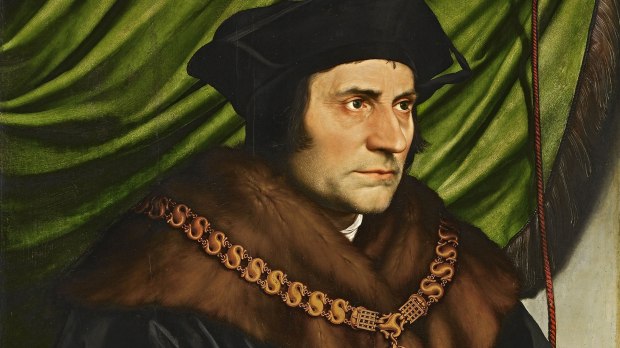Containing more than 60 historical artifacts from More’s time, as well as several first-class relics of More and St. John Fisher, a new exhibit is open daily at the St. John Paul II Shrine in Washington, D.C., until March 31, 2017. Its title — “God’s Servant First: The Life and Legacy of Thomas More” — refers to More’s last words before being beheaded: “I die the King’s good servant, and God’s first.”
While the exhibit gives attention to More’s early life, it zeroes in on the events leading to his execution by King Henry VIII, beginning with Pope Clement VII’s refusal to declare null Henry’s marriage to Catherine of Aragon. The King responded by proclaiming himself the Supreme Head of the Church in England so that he could grant himself the annulment and marry his mistress Anne Boleyn. More knew that publicly opposing the king would endanger his family, so he resigned as Chancellor of England and kept silent. But because of More’s reputation for learning and virtue, Henry was determined to have More approve his marriage, and consequently enacted a law requiring his subjects to acknowledge his headship of the English Church. When More refused to do so, he was imprisoned, convicted of treason, and beheaded.
So, More lost his head over the headship of the Church — but also because he was willing to do what all martyrs do: give his life for the truth. King Henry wanted to believe that he could dissolve his marriage on his own authority, and he wanted men of repute such as More to back him up. But More refused, silently bearing witness to the truths of papal authority and the indissolubility of marriage.
The theme of the exhibit is made clear from the start with a quote from St. John Paul II: “The life and martyrdom of Saint Thomas More . . . speaks to people everywhere of the inalienable dignity of the human conscience.” The full significance of this theme, however, only becomes apparent in the part of the exhibit on More’s legacy. While arguing that More’s example helped promote the spread of religious liberty in America and the world, the exhibit also describes the history of anti-Catholicism in this country, and ends with an ominous quote from G. K. Chesterton: Thomas More “is more important at this moment than at any moment since his death … but he is not quite so important as he will be in about a hundred years time.”
The implication is obvious: More is particularly relevant to our times because he was a martyr for the very liberty that is now threatened by the American government’s increasing efforts to force Catholics to act against their consciences on such issues as contraception and gay marriage. The exhibit is not alone in connecting More’s death with the situation of Catholics today: Before coming to the exhibit, the relics of More and Fisher were venerated as part of the U.S. Conference of Catholic Bishops’ Fortnight for Freedom campaign.
In my view, the exhibit is undoubtedly correct about More’s relevance for our times. For we too are facing an attack by government authority on the truth about marriage: Just as King Henry denied its indissolubility, today our government denies that it is solely between a man and a woman, and that contraception is contrary to its very nature. Like King Henry, our government wishes to compel our assent to what we know to be untrue. And like More, we must respond by witnessing to the truth, even if it means suffering persecution.
More is not only “a man for all seasons,” as Robert Whittington called him, but a man especially for our time. And in studying his martyrdom, we not only learn about our past, but contemplate our future.

